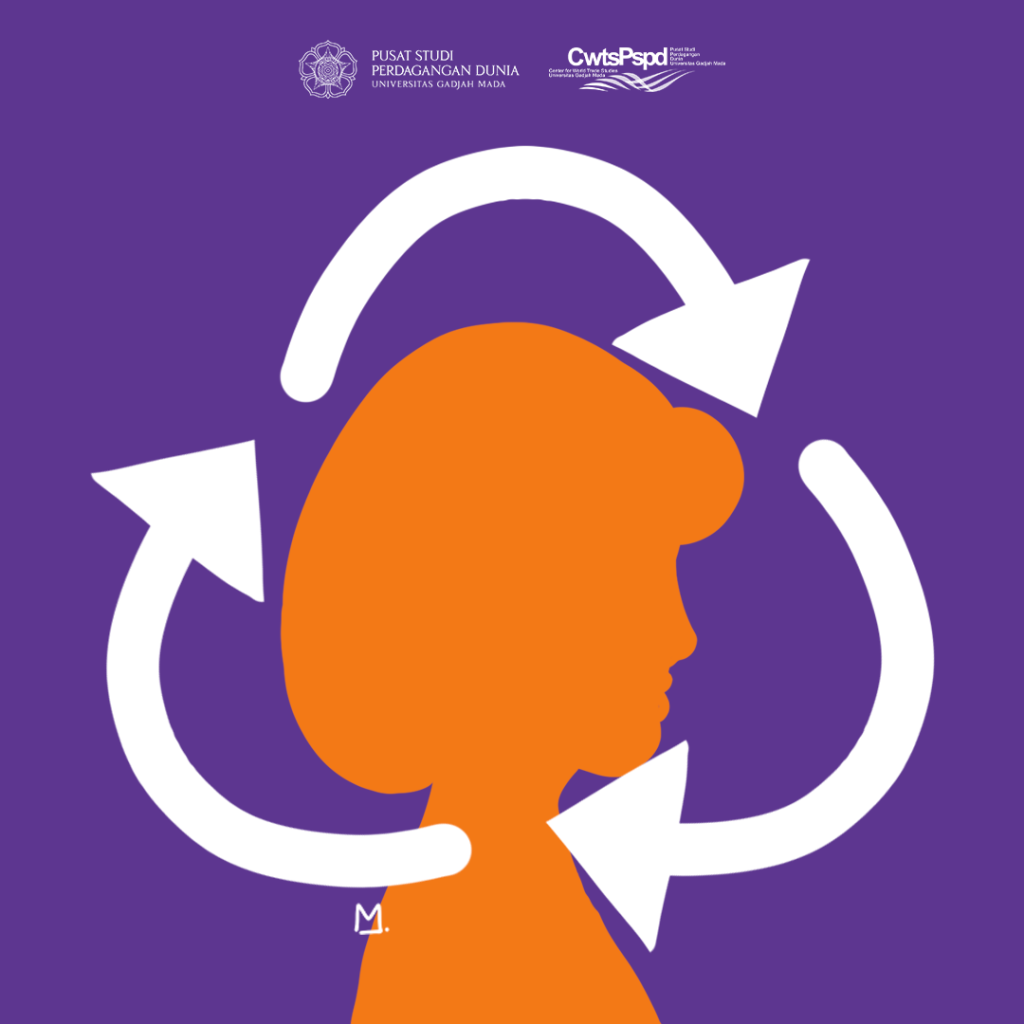Ilustrasi Oleh: Marsha

Written by:
Hannah Dayman
Deakin University
CWTS UGM-ACICIS Intern (January – February 2022)
The implementation of circular economy principles in countries around the world is as recent as it is varied, with states working alongside international organisations such as the Organisation for Economic Co-operation and Development (OECD) to encourage the fulfilment of the Sustainable Development Goals (SDGs). Circular economy (CE) and its influence on social development is a relatively new area of research, particularly regarding the relationship between CE and gender equity. The OECD has released research and frameworks on areas where the implementation of CE may affect and increase gender equity. The 2019 OECD report on CE and gender highlights areas of environmental degradation, the globalised fashion industry, waste management, and women's consumer patterns as critical components that will be affected where CE policy is implemented. A common trend in the gender analysis applied by organisations of the global North is a lack of differentiation between women from different socio-political and cultural backgrounds. The OECD undertook studies of gendered patterns from developed and developing countries; however, there was little emphasis regarding how women's socio-economic circumstances would reap different results and how this reflects in local governmental policy. The one-size-fits-all approach fails to provide much needed context when seeking to implement policy or commit resource allocation to grassroots initiatives and programs that empower the individual. This article aims to deconstruct how international organisations, such as the OECD, understand the relationship between CE and gender, using Indonesia as a representative case study for CE's application in developing countries and Australia as a case study for developed countries.
The concept of environmental sustainability has been a rapidly growing movement since the 1960s and '70s. However, the Australian government did not integrate the CE framework until the 2018 National Waste Policy. Since then, think tanks such as the Commonwealth Scientific and Industrial Research (CSIRO) have been tasked with investigating the benefits of CE in an Australian context. Australia's environmental and economic sustainability journey is seemingly in its research and discovery phase. Without a strong push from policymakers and government ministers, corporations have little incentive to adopt the framework themselves. Even though many international organisations and Australian-led think-tanks have proved CE to benefit business owners and consumers both fiscally and environmentally, corporate hesitation derives from a lack of information, understanding, and 'top-down' incentives. As a result, most efforts toward CE in Australia have been made by investors and consumers.
Women, in particular, have been progressing the CE movement in extraordinary ways. Generally, women as consumers are a powerful influence and statistically inclined to be the group most responsible for small, frequent household purchases, and having a high literacy regarding eco-branded product labels. While women are not the only members of Australian society that are using their purchasing power to direct companies to adopt a CE method of practice, they are further involved in several initiatives to educate consumers and change Australian industries. For example, 2018 saw the inaugural Australia Circular Fashion Conference that covers 'advocacy and awareness towards consumer change management'. Furthermore, the South Australian government have implemented the 'Women in Circular Economy Leadership Awards', selecting one woman each year to represent CE in action through education efforts and environmentally sustainable management practices. According to the OECD report, these examples demonstrate gender-specific consumption patterns and the active promotion of women's role in CE.
In addition to consumer power driving corporations into greener economic practices, the adoption of CE in Indonesia affects women as producers and informal, unpaid workers. This is primarily due to poor working conditions and exposure to toxic pollutants that are the by-product of the work women typically undertake. While Indonesia has gained momentum in its transition into a green economy, policymakers are yet to give necessary weight to women-focused programs and initiatives within the scope of CE. A 2021 report led by Kementerian PPN Bappenas and the Danish Embassy highlighted Indonesia's vital economic sectors that would best suit CE implementation. The OECD report was cited within the analysis, indicating women are the most likely to benefit from CE in Indonesia. Among the reasons for this is greater access for women to formal, green jobs creating financial security, less exposure to dangerous chemicals used in work practices, or from plastic burning in waste management. The report stated that women are likely to fill up to 75 per cent of the potential green jobs available through CE. Similarly to Australia, however, policymakers fail to give appropriate credence to the connection between CE and gender equity. The United Nations (UN) SDGs Roadmap for Indonesia, CE, is listed as a recommendation for Goal 8 (decent work and economic growth), with no mention of the potential impacts CE has on Goal 5 (gender parity and women's empowerment).
Grassroots programs in Indonesia have identified the beneficial relationship between CE and gender. There are several programs that have been identified in the greater Jakarta region by a 2018 study. Examples include the Gerakan Indonesia Kantong Plastik (Indonesia's Plastic Bag Diet Movement), Waste4Change – which provides corporations, communities, and individuals consultancy and support in green waste management, and SiDalang – which provides ‘training on upcycling and business development to local women'. Grassroots organisations and SMEs are ostensibly driving the force behind Indonesia's acceptance and future with a CE through their prioritising waste management and the re/up-cycling of waste resources. Results of women participating in these upcycling training and social enterprise programs demonstrate the benefits the OECD report highlighted. This includes improved life skills and the ability to experience and explore entrepreneurship, thus improving overall welfare.
While the connection between CE and gender equity has been established and investigated by international organisations and states alike, further prioritisation must be placed on supporting organisations and programs that facilitate and encourage the relationship. The contrast between CE influence on women in Australia and Indonesia is evident. The OECD report is comprehensive insofar as it identifies how women are affected by CE and how women globally work, consume, and influence. For example, women in higher socio-economic positions can be involved in CE through their consumer power; by influencing corporations and businesses to implement greener production processes. Equally, women who work in unsafe conditions due to the linear economy will benefit from the incorporation of circular practices that will provide better jobs, financial stability, and enhanced overall wellbeing. The OECD report and consequential research aiming to understand the connection between CE and gender is the first step to a green future. However, further advocacy is needed to establish a specific, local policy that centres on women as crucial actors in CE, considering individuals' strengths and limitations based on socio-economic and cultural standpoints.

